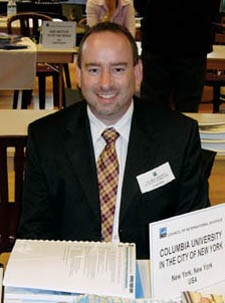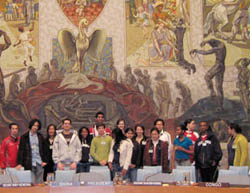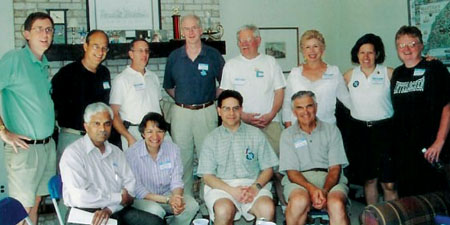|
|
 |
 |
|
ABOARD THE ARCAlumni Representative Committee Plays Key Role in Admissions ProcessBy Shira Boss-Bicak ’93, ’97J, ’98 SIPA

ARC member Jorge Hirter ’85 represents Columbia at a College Fair in Geneva. 
With the start of another school year, alumni often become nostalgic for their College days. In addition to indulging in memories and reconnecting with classmates and the school through Homecoming and alumni get-togethers, thousands of alumni take an active part recruiting and interviewing high school students as members of the worldwide Alumni Representative Committee (ARC). The admissions office relies on alumni for local outreach and to help interview as many students as possible during the application season from October to March. Of the more than 17,000 College applications received last year, approximately 9,000 ARC interviews were conducted. Interviewing students is ARC’s main activity, but members also participate by representing Columbia at college fairs, serving as local contacts for schools and hosting or attending informational sessions for prospective applicants or receptions for admitted applicants in their regions. “You are playing an important role, not just in who will be admitted, but in which of our accepted students choose to matriculate,” says Alan Freeman ’93, chair of the Washington, D.C., ARC chapter. “A huge number of students who choose Columbia over a compelling peer institution identify contact from alumni as one of the reasons they chose to come to Columbia,” says Alec Milton ’04 TC, senior assistant director of admissions and ARC director. Reasons alumni join ARC and volunteer their time include wanting to give back to the College, staying connected with the school, helping to shape the incoming classes, having an opportunity to keep abreast of how Columbia is changing and enjoying the process of meeting bright, young people. “It lets me relive my youth a little bit,” says Nancy Perla ’01, ARC Arizona chair. “Getting to know the Columbia candidates, if only for a brief while, takes me right back to that emotional place where I was at 17. The world was full of possibilities and uncertainties. It was exciting and scary at the same time. That’s a universal experience — watching others go through it, you sometimes see a bit of yourself.” Freeman says ARC gives him a reason to keep up with what’s happening on campus, from curriculum changes to new buildings to student activities. He reads Spectator online and ARC’s monthly e-newsletter, Roar, Lions, Roar! 
ARC has been changing with the times, most notably

Being involved with ARC also is an opportunity to meet interesting students and influence their decisions about where to attend college. Simon Salas ’79, ’83L, ’83 SIPA came to Columbia from San Antonio and eventually returned to the area, where he spends 40 – 50 hours each fall chairing the local ARC chapter. “I do several college fairs a year and try to do at least one in non-traditional areas with students who would not by-and-large be considered Columbia-bound,” Salas says. “That’s the type of high school I went to. It’s important to remember that there is talent everywhere.” Each fall, Salas recalls his arrival on the Morningside Heights campus and thinks about how the new students will be having great experiences, as he did. In speaking with students, he also notes how their career interests shift with current events. “In the last few years, more students have been interested in international relations; that has to do with 9-11,” he says. “It’s interesting to see how students are affected by what’s happening.” ARC has been changing with the times, most notably by moving to an entirely online process, including electronic filing and accessing of interview reports. Instead of the former paper system, now the admissions office coordinates local applicants with alumni interviewers through a local chairperson, all through the Columbia E-Community. The change was made four years ago and has made it easier to recruit alumni volunteers. During the past three years, 2,000 alumni have joined ARC. Alumni interviewers are assigned applicants through their local chairperson. They are notified online and accept or decline assignments, contact students, get basic information on an applicant and write and submit reports through the ARC section on the E-Community. Once a report is submitted, it is automatically appended to a student’s application at the admissions office. The admissions office has been communicating more closely with ARC volunteers, notably through the monthly e-newsletter, which gives brief updates on campus, student and alumni news and events. The e-newsletter keeps alumni informed about Columbia and helps them give applicants the most current portrayal of the school. This becomes especially useful the longer alumni have been away from campus and the more it has changed in their absence. ARC also is a way for College alumni to connect locally, as members might gather for an informational session or send-off party and, in some cases, among themselves. The San Antonio ARC, for example, has for several years given a reception for admitted students, and this past winter inaugurated a dinner for ARC members to socialize and “build a foundation for doing other things to promote Columbia,” Salas says. 

A group of admitted students spent an afternoon touring the United Nations, including the Security Council, thanks to U.N. official Fernando Ortiz ’79. 
Interviewing applicants is ARC’s largest element. “Actually sitting with a young person, delving into his or her soul just a little bit and writing up your reflections,” Perla says, “is like getting to be a college admissions officer, a psychoanalyst and a journalist all at once.” Interviews are meant to be conversant both ways, rather than an interrogation. A principle aim is to give an applicant personal contact with a Columbian so the applicant can ask questions and get an impression of the school. Even students who don’t live far from New York sometimes don’t have a chance to visit campus, so the alumni interview — or group information session — might be the only personal contact they have with someone from the Columbia community. “A lot of times, I am a salesman for the College, and it’s fun to play that role,” says Freeman. The second aim is for the interviewer to help assess the applicant’s fit for Columbia and New York City. The hope is to get insights about a student’s intellectual and social character and fit that don’t come through in the rest of the application, and to determine his or her knowledge of Columbia. “Is a student going to bring an interesting voice and perspective to the conversations taking place here, both in and out of the classroom?” says Jessica Marinaccio, executive director of Undergraduate Admissions, describing what ARC memebers are seeking. “Will he or she thrive in and take advantage of the opportunities offered through both New York City and the Core?” The admissions office also asks that ARC members be cognizant of the pressure students feel in a college interview. “The application process is an intense time for most students and we want the interview dynamic to be comfortable and relaxed,” says Marinaccio. 
One reason alumni join ARC and volunteer 
“When I was in high school, I lived in the Philippines and never got the chance to meet any Columbia alumni and never saw the campus before the first day of orientation,” says Karen Lee ’92, who was a College admissions officer from 1994–97 and now is ARC’s Hawaii chairperson. “As a result, I find that I go out of my way to portray Columbia and NYC as realistically and favorably as possible. I always tell students that Columbia is not for everyone. We are looking for independent self-starters who love the Core Curriculum and will take advantage of the city.” Columbia applicants are expected to demonstrate knowledge of and interest in the school. “They’ll say, ‘I’ve always wanted to go to Columbia,’ but you can see which ones mean it,” says Salas. Each year, the College receives between 15 and 20 applications for each space in the incoming class, so many qualified candidates must be turned down. That’s a disappointment for many interviewers who have given them high recommendations, but something ARC members learn to accept. 

Parents join ARC members at a recent send-off event in Michigan: (rear, from left) Tom Reuter ’78, Jim Jacobs P’10, Howard Stubiner P’10, Jim Godfrey P’10, Franklin Mirer ’66, Sandy Klyman ’58 Barnard, Grace Reuter ’78 Barnard and Karen Rodal P’10; (front, from left) Drs. Mohan and Bhaskaran P’10, Brent Davidson P’08 and George Stern ’58. 
In addition to a written, descriptive report about the interview — Milton says that the more details included, the more helpful the report — alumni give a student a 1–5 rating. But it’s not your typical grading system. On this scale, “strong recommendation” is the midpoint, or 3. “The overwhelming majority of our applicants are incredibly strong, true standouts in their respective communities,” Marinaccio says. “Over the last 10 years, applications to Columbia have nearly doubled. The overall quality of the applicant pool has increased as well, so we’ve adjusted our rating system to reflect what we’re seeing. If a student is rated a 4 or a 5, then the interview report needs to provide compelling evidence why that applicant is extraordinary.” After students are admitted, ARC members sometimes follow up with them as a further personal introduction to the school or as a recruitment effort to get them to choose Columbia over another school that accepted them. The day after Kendra Crook ’95 received her acceptance letter in Maine, the local ARC member she had interviewed with called to congratulate her. That helped convince her parents about the school, says Crook, who has been interviewing students since shortly after her graduation. “My mom had the sense I’d be joining a real community,” she says. By The Numbers
How To Get InvolvedTo be involved with the Alumni Representative Committee, alumni need to belong to the free Columbia E-Community. To join ARC, log into the E-community and click on “communities” to locate ARC and sign up. For additional information, contact Alec Milton ’04 TC, senior assistant director of admissions and ARC director: am1340@columbia.edu or 212-854-1512. Shira Boss-Bicak ’93, ’97J, ‘98 SIPA is a journalist in Manhattan and a member of the Alumni Representative Committee for the Bronx.
|
|
||||||||||||||||||||||||||||




